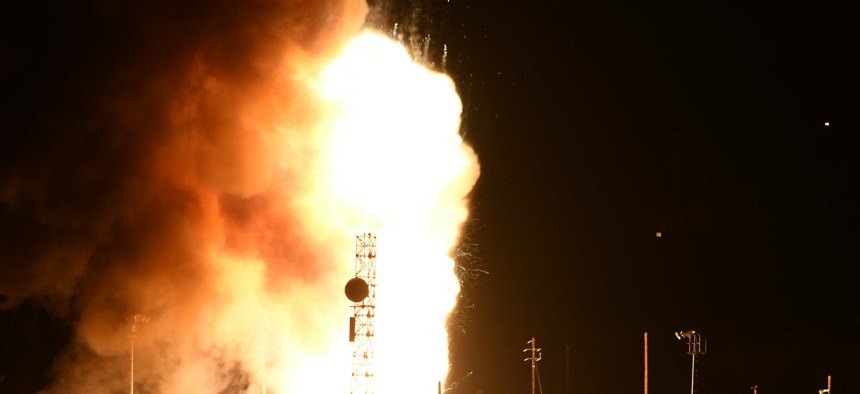
An Air Force Global Strike Command unarmed Minuteman III intercontinental ballistic missile launches during an operation test at 11:49 p.m. PT Feb. 23, 2021, at Vandenberg Air Force Base, Calif. U.S. Space Force / Tech. Sgt. Brittany E. N. Murphy
Milley’s Hypersonic Hyperbole May Have Been His ‘Missile Gap’ Moment
The United States must avoid another arms race based on untested or distinctly false premises.
After last month’s Chinese test of a hypersonic missile, Joint Chiefs of Staff chair Gen. Mark Milley described it as “very close” to a “Sputnik moment,” alluding to the Soviet Union’s 1957 satellite launch that sent shock waves through U.S. media, government, and society. The concern was that if Moscow could put a radio beacon into orbit, a nuclear-armed, long-range ballistic missile could not be far behind. The event, which displayed an unexpected level of technological sophistication, sparked a surge in U.S. investment in military, space, and scientific research and development.
But Gen. Milley’s Sputnik sound bite doesn’t hold up. China’s ability to put a hypersonic missile into space should have been no great surprise, given Beijing’s long efforts to develop related technology. And the Chinese test missile missed its target by 24 miles, suggesting that Beijing still has a ways to go in mastering hypersonic flight. As veteran defense analyst and nuclear weapons expert Fred Kaplan has noted, “a new type of Chinese missile is triggering panic among some U.S. defense officials, but the alarms are overblown.”
A closer analogue to the Chinese test may be the missile gap controversy of the 1950s, in which military officials, the arms industry, and prominent Democratic Senators alleged that the Eisenhower administration had allowed the United States to “fall behind” in the development and production of intercontinental ballistic missiles, to the detriment of national security. After some resistance, the Eisenhower administration boosted ICBM production and deployment, a pivotal move that set the stage for the intense U.S.-Soviet arms race of the 1960s. The Kennedy administration proceeded with the race even after U.S. intelligence revealed in 1961 that, in fact, the U.S. ballistic missile force far outstripped that of the Soviet Union. Defense Secretary Robert McNamara decided to build 1,200 ICBMs, despite analyses from his own department that a substantially lower figure would be sufficient for deterrence. Thankfully, he resisted the Strategic Air Command’s proposal to build up to 10,000 of such missiles. But a missile race based on false premises proceeded nonetheless.
Will the nascent arms race over hypersonics turn out to be Gen. Milley’s missile-gap moment? It’s too soon to tell, but there is already evidence that the utility, technical proficiency, and reliability of hypersonic missiles are unlikely to be all they are cracked up to be. There is also the question of cost. Paul Schaare and Ainikki Riikonen of the Center for a New American Security warn that “Even once the technology is developed, hypersonic missiles are unlikely to be affordable enough to be anything other than an exquisite silver bullet for the highest priority targets.” Their assessment may or may not play out given the Pentagon’s ability to throw money at new weapons concepts.
As Kaplan has further noted, the United States and its main adversaries already have hypersonic missiles: ICBMs. They travel at almost four times the speed that hypersonic missiles are hoped to achieve, and despite the tens of billions spent by the United States on missile defenses, enemy ICBMs are likely to reach their targets unhindered, especially if they are outfitted with multiple warheads and accompanying decoys.
Of course, ICBMs have a serious downside in that the president would have only a matter of minutes to decide whether to use them in a crisis, greatly increasing the risk of an accidental nuclear war based on a false alarm. A similar problem could arise if hypersonic missiles were ever to be armed with nuclear weapons, a capability that both Russia and China seem to be considering. As Kingston Reif and Shannon Bugos of the Arms Control Association have explained, “With as little as five minutes to assess an attack—the time it would take a hypersonic glide vehicle to traverse 2,000 miles—a defender would be understandably hard pressed to avoid worst-case assumptions.” The best way to reduce nuclear risk would be to eliminate ICBMs and curb the development of hypersonics, not engage in a new, costly competition that would make the world a more dangerous place.
There is no shortage of ideas on how to reduce the risks posed by the development of hypersonic missiles: ban them outright, limit their range, cap their number, increase transparency regarding developments in each of the countries working on them. A solid menu of options is contained in a new report from the Arms Control Association. The report also provides a detailed listing of the risks posed by unbridled development and deployment of hypersonics, including the fact that a country would have a hard time distinguishing between a conventionally or nuclear-armed hypersonic missile, increasing the possibility of nuclear escalation.
It’s time for a sober assessment of the risks posed by hypersonic missiles, not a campaign of hyperbole or a sense of panic that could drive an unnecessary new arms race.
William D. Hartung is the director of the Arms and Security Program at the Center for International Policy.



